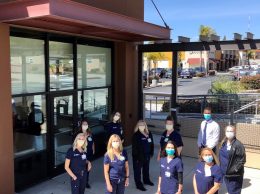
Although San Luis Obispo’s real estate prices are lower than in many other parts of the Tri-Counties, wages are lower too, and by a wider margin. That makes the Central Coast one of the least affordable places in the United States, according to economists. (Creative Commons photo)
A vast majority of San Luis Obispo County employees and employers say suitable and affordable housing is difficult to find in the area, according to a recent workforce survey by the Economic Vitality Corp.
The findings highlight a pervasive mismatch between the high price of even starter homes and the number of jobs that pay wages high enough to support those prices. Experts say the gap is a significant roadblock to the state’s economic growth.
The disparity is particularly acute in the coastal communities on the Central Coast, where the region’s desirability and environmental regulations drive up the cost of living faster than head-of-household jobs are created.
The EVC survey was taken by 354 employees and 154 employers in the county between October 2011 and January 2012. It found that 88 percent of employees and 83 percent of employers said finding affordable housing suitable to their needs was “somewhat difficult” to “very difficult.” Additionally, 80 percent of employees said they were limited in their housing options, and 26 percent of employees felt that they had little to no choice in their housing situation.
The survey also showed that 27 percent of employees and 11 percent of employers say they are somewhat to very likely to move away from the area, with cost of living listed as the top reason for leaving. Of the respondents, 78 percent of employees and 84 percent of employers live in single detached homes. Sixty-three percent of employees are homeowners rather than renters, while about 80 percent of employers own rather than rent.
Wages are part of the problem
San Luis Obispo real estate prices are actually slightly lower than other parts of the Tri-Counties, but average wages are lower by a larger margin.
Leonard Grant, co-chair of the EVC’s building, design and construction cluster, said the county has one of the least affordable levels of housing in the United States when taking into account the ratio between income and housing prices. This makes it considerably harder for the county to bring in and retain the talent it needs to grow its economy, he said.
“The cluster is addressing the question: Why is the cost of living so high and how can we bridge the gap and make progress towards getting smaller less expensive units built?” Grant said.
Grant said the survey characterizes the specific housing needs and preferences of the county’s workforce. The organization will use this information to generate discussion between developers, government agencies and community members on how to provide housing that best meets this range of needs, he said.
In order to effectively address the problem, Grant said, a solution will need to take into account economic, political and environmental barriers standing in the way.
Grant said the county would like to see more high-density housing built in order to make the most efficient use of limited land and allow for more affordable prices.
However, developers are reluctant to build higher density projects because of the risk of getting bogged down by county review processes and a smaller profit per unit, he said.
“The next step is to come up with creative solutions that are a more efficient use of the land,” Grant said. “It’s a going to take an effort where the government says they are willing to look outside the box and developers are willing to build if some of the risk is mitigated.”
Wants vs. needs
Ted Bench, a planner for the SLO County Planning and Building Division, said the county helped fund the survey project and will be working closely with the EVC as well as other stakeholders such as the SLO Workforce Housing Coalition and the Homebuilder’s Association.
Bench said the county’s goals are to streamline its building permitting process and meet its target numbers for low- to moderate-income housing set by the county’s plans.
Those plans define “workforce housing” as meeting the needs of residents with an income between 120 percent and 160 percent of the median income for the area. Moderate income is defined as less than 120 percent of the median, low as less than 80 percent and very low as less than 30 percent.
Christine Rogers, a program manager for the EVC, said the key is to identify the specific type of housing demands for each demographic and provide housing with a range of affordability. The survey found that the highest demand among all respondents was for a three-bedroom house with two garage spaces within a maximum commute time of 30 minutes.
“We found there was most often a disparity between what people can afford and what they want,” Rogers said.
A regionwide issue
The affordability of housing is a problem for the entire region, and it can become a self-fulfilling prophecy, said Bill Watkins, head of California Lutheran University’s Center for Economic Research and Forecasting. One consequence of shortages in affordable housing tends to be demand for higher wages, which in turn lead to a decrease in the production of goods that are traded outside the area because they can’t compete with goods from areas with lower wages. The cost of non-tradable goods produced and sold in the area then rises, driving up the cost of living further.
According to a report released this year by the National Low Income Housing Association, a San Luis Obispo County resident would hypothetically need to work 1.9 full time jobs at the county’s average renter wage in order to afford a two bedroom house priced at fair market rent, a Santa Barbara County resident 1.8 and a Ventura County resident 1.9. The California state average is 1.4.
The report also lists California as the state with the second most expensive housing behind Hawaii and the Ventura County area as the eighth most expensive metropolitan area in the United States. The ranking is determined by the wage needed to afford a two-bedroom house.
Alex Russell, chair of Ventura-based nonprofit Housing Opportunities Made Easier, said the slashing of redevelopment funds and lack of federal funding has taken a major toll on the amount of affordable housing available. He said local governments are attempting to compensate for this through policies such as density bonuses for affordable housing, but problems continue to mount.
“Each city is making unique efforts to provide affordable housing for its residents and we are all still coming to terms with the new reality in which there is little developable land in our county, local redevelopment agencies have been eliminated, populations continue to grow and the overall economy is weak,” Russell said in an email.






 Print
Print Email
Email
















